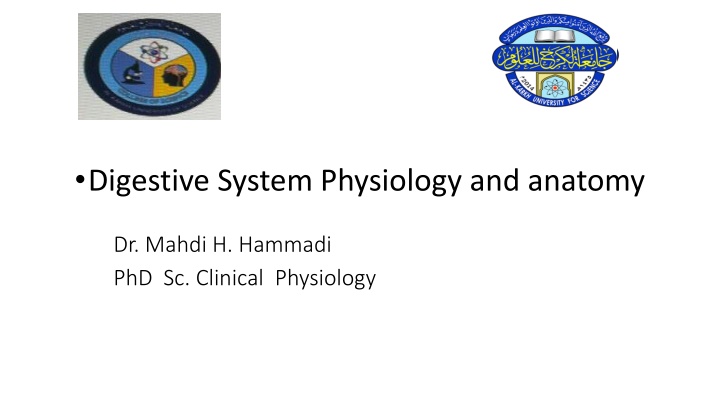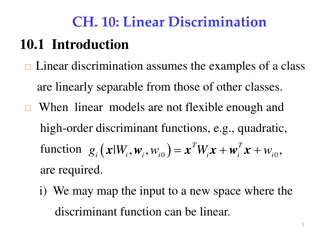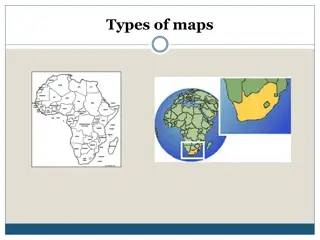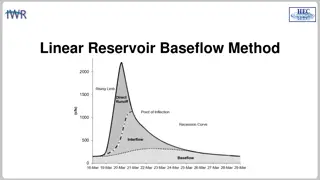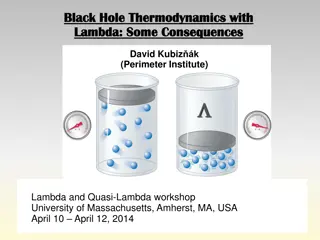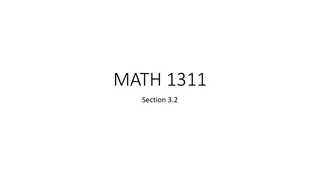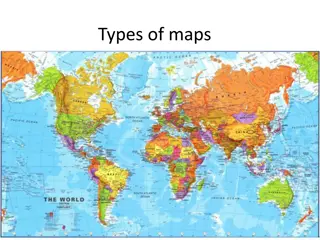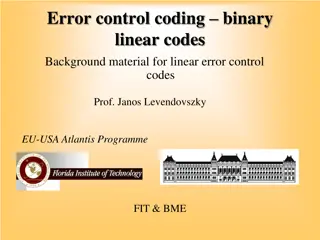Visualising Linear Lambda Terms as Rooted Maps
The lambda calculus, a model of computation using variable abstraction and application, allows for the representation of programs through constructs like bound and free variables. Terms in lambda calculus can be equivalently renamed using alpha-conversion or represented through de Bruijn indices to simplify notation. Understanding function application and reduction strategies through normalisation graphs is key in reaching a term's normal form.
Download Presentation

Please find below an Image/Link to download the presentation.
The content on the website is provided AS IS for your information and personal use only. It may not be sold, licensed, or shared on other websites without obtaining consent from the author.If you encounter any issues during the download, it is possible that the publisher has removed the file from their server.
You are allowed to download the files provided on this website for personal or commercial use, subject to the condition that they are used lawfully. All files are the property of their respective owners.
The content on the website is provided AS IS for your information and personal use only. It may not be sold, licensed, or shared on other websites without obtaining consent from the author.
E N D
Presentation Transcript
Digestive System Physiology and anatomy Dr. Mahdi H. Hammadi PhD Sc. Clinical Physiology
Anatomy of the Digestive System The functions of the digestive system are: Ingestion. Propulsion. Food breakdown: mechanical digestion. Food breakdown: chemical digestion. Absorption. Defecation.
Organs of the Alimentary Canal The alimentary canal, also called the gastrointestinal tract, is a continuous, hollow muscular tube that winds through the ventral body cavity and is open at both ends. Its organs include the following:
Mouth Related image
Pharynx From the mouth, food passes posteriorly into the oropharynx and laryngopharynx. Oropharynx. The oropharynx is posterior to the oral cavity. Laryngopharynx. The laryngopharynx is continuous with the esophagus below; both of which are common passageways for food, fluids, and air.
Esophagus The esophagus or gullet, runs from the pharynx through the diaphragm to the stomach.
Structure. The walls of the alimentary canal organs from the esophagus to the large intestine are made up of the same four basic tissue layers or tunics Mucosa. Submucosa. The submucosa is found just beneath the mucosa . Muscularis externa. The muscularis externa is a muscle layer typically made up of an inner circular layer and an outer longitudinal layer of smooth muscle cells. Serosa. The serosa is the outermost layer of the wall that consists of a single layer of flat serous fluid- producing cells, the visceral peritoneum. Intrinsic nerve plexuses. The alimentary canal wall contains two important intrinsic nerve plexuses- the submucosal nerve plexus and the myenteric nerve plexus, both of which are networks of nerve fibers that are actually part of the autonomic nervous system and help regulate the mobility and secretory activity of the GI tract organs.
Location. The C-shaped stomach is on the left side of the abdominal cavity, nearly hidden by the liver and the diaphragm. Function. The stomach acts as a temporary storage tank for food as well as a site for food breakdown. Cardiac region. The cardiac region surrounds the cardioesophageal sphincter, through which food enters the stomach from the esophagus. Fundus. The fundus is the expanded part of the stomach lateral to the cardiac region
Body. The body is the midportion, and as it narrows inferiorly, it becomes the pyloric antrum, and then the funnel-shaped pylorus. Pylorus. . Size. The stomach varies from 15 to 25 cm in length Rugae. The mucosa of the stomach is thrown into large folds called rugae when it is empty. Stomach mucosa. The mucosa of the stomach is a simple columnar epithelium composed entirely of mucous cells that produce a protective layer of bicarbonate-rich alkaline mucus that clings to the stomach mucosa and protects the stomach wall from being damaged by acid and digested by enzymes. Gastric glands. This otherwise smooth lining is dotted with millions of deep gastric pits, which lead into gastric glands that secrete the solution called gastric juice. Intrinsic factor. Some stomach cells produce intrinsic factor, a substance needed for the absorption of vitamin b12 from the small intestine.
Chief cells. . Parietal cells. The parietal cells produce corrosive hydrochloric acid, . Enteroendocrine cells. The enteroendocrine cells produce local hormones such as gastrin . Chyme. After food has been processed, it resembles heavy cream and is called chyme
Location. The small intestine is a muscular tube extending from the pyloric sphincter to the large intestine. Size. It is the longest section of the alimentary tube, with an average length of 2.5 to 7 m (8 to 20 feet) in a living person. Subdivisions. The small intestine has three subdivisions: the duodenum, the jejunum, and the ileum, which contribute 5 percent,
nearly 40 percent, and almost 60 percent of the small intestine, respectively. Ileocecal valve. The ileum meets the large intestine at the ileocecal valve, which joins the large and small intestine. Hepatopancreatic ampulla. The main pancreatic and bile ducts join at the duodenum to form the flasklike hepatopancreatic ampulla, literally, the liver-pacreatic-enlargement . Duodenal papilla. From there, the bile and pancreatic juice travel through the duodenal papilla and enter the duodenum together. Microvilli. Microvilli are tiny projections of the plasma membrane of the mucosa cells that give the cell surface a fuzzy appearance, sometimes referred to as the brush border; the plasma membranes bear enzymes (brush border enzymes) that complete the digestion of proteins and carbohydrates in the small intestine. Villi. Villi are fingerlike projections of the mucosa that give it a velvety appearance and feel, much like the soft nap of a towel.
Lacteal. Within each villus is a rich capillary bed and a modified lymphatic capillary called a lacteal. Circular folds. Circular folds, also called plicae circulares, are deep folds of both mucosa and submucosa layers, and they do not disappear when food fills the small intestine. Peyer s patches. In contrast, local collections of lymphatic tissue found in the submucosa increase in number toward the end of the small intestine
Large Intestine The large intestine is much larger in diameter than the small intestine but shorter in length.
